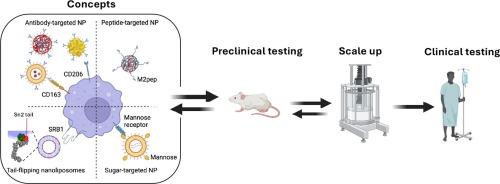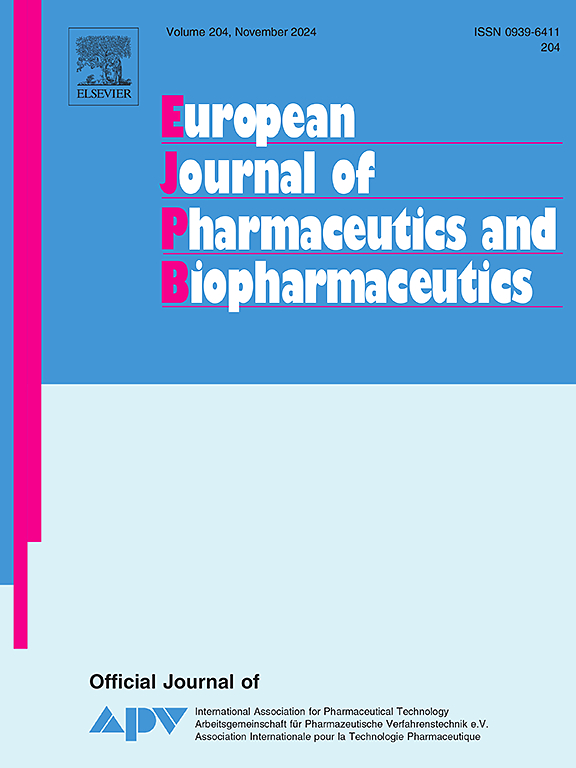Targeted nanomedicine for reprogramming the tumor innate immune system: From bench to bedside
IF 4.4
2区 医学
Q1 PHARMACOLOGY & PHARMACY
European Journal of Pharmaceutics and Biopharmaceutics
Pub Date : 2024-09-21
DOI:10.1016/j.ejpb.2024.114510
引用次数: 0
Abstract
Tumor-associated innate immune cells such as tumor-associated macrophages, neutrophils, dendritic cells play a crucial role in tumor progression, angiogenesis and metastasis. These cells also control the efficacy of chemotherapy and immunotherapy by inducing drug resistance and immunosuppression, leading to therapeutic failures. Therefore, targeting the tumor-associated innate immune cells has gained high attention for the development of effective cancer therapy. Nanomedicine based strategies to target these cells are highly relevant and can be used to reprogram these cells. In this review, we discuss the fundamental roles of the tumor-associated innate immune cells in the tumor microenvironment and different strategies to modulate them. Then, nanomedicine-based strategies to target different tumor innate immune cells are explained in detail. While the clinical development of the targeted nanomedicine remains a great challenge in practice, we have provided our perspectives on various factors such as pharmaceutical aspects, preclinical testing and biological aspects which are crucial to consider before translating these targeting strategies to clinics.

重编程肿瘤先天免疫系统的靶向纳米药物:从工作台到床边。
肿瘤相关先天性免疫细胞,如肿瘤相关巨噬细胞、中性粒细胞、树突状细胞,在肿瘤进展、血管生成和转移中发挥着至关重要的作用。这些细胞还通过诱导耐药性和免疫抑制控制化疗和免疫疗法的疗效,导致治疗失败。因此,针对肿瘤相关先天性免疫细胞开发有效的癌症疗法已受到高度关注。以纳米药物为基础的靶向这些细胞的策略具有高度相关性,可用于对这些细胞进行重编程。在这篇综述中,我们将讨论肿瘤相关先天性免疫细胞在肿瘤微环境中的基本作用以及调节这些细胞的不同策略。然后,详细解释了针对不同肿瘤先天性免疫细胞的基于纳米药物的策略。虽然靶向纳米药物的临床开发在实践中仍是一个巨大的挑战,但我们从制药方面、临床前测试和生物学方面等各种因素提出了自己的观点,这些因素在将这些靶向策略转化为临床药物之前至关重要。
本文章由计算机程序翻译,如有差异,请以英文原文为准。
求助全文
约1分钟内获得全文
求助全文
来源期刊
CiteScore
8.80
自引率
4.10%
发文量
211
审稿时长
36 days
期刊介绍:
The European Journal of Pharmaceutics and Biopharmaceutics provides a medium for the publication of novel, innovative and hypothesis-driven research from the areas of Pharmaceutics and Biopharmaceutics.
Topics covered include for example:
Design and development of drug delivery systems for pharmaceuticals and biopharmaceuticals (small molecules, proteins, nucleic acids)
Aspects of manufacturing process design
Biomedical aspects of drug product design
Strategies and formulations for controlled drug transport across biological barriers
Physicochemical aspects of drug product development
Novel excipients for drug product design
Drug delivery and controlled release systems for systemic and local applications
Nanomaterials for therapeutic and diagnostic purposes
Advanced therapy medicinal products
Medical devices supporting a distinct pharmacological effect.

 求助内容:
求助内容: 应助结果提醒方式:
应助结果提醒方式:


